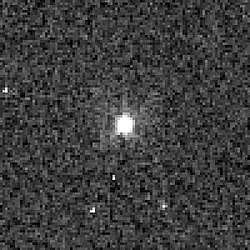1042 Amazone
1042 Amazone, provisional designation 1925 HA, is a dark asteroid and slow rotator in the outer asteroid belt, approximately 70 kilometers in diameter. It was discovered on 22 April 1925, by German astronomer Karl Reinmuth at Heidelberg Observatory in southern Germany.[1] It is named after the Amazons from Greek mythology.[2]
 Hubble Space Telescope image of Amazone taken in 2013 | |
| Discovery [1] | |
|---|---|
| Discovered by | K. Reinmuth |
| Discovery site | Heidelberg Obs. |
| Discovery date | 22 April 1925 |
| Designations | |
| (1042) Amazone | |
| Pronunciation | German: [ˈaːmaːtsoːnə] |
Named after | Ἀμαζών Amazōn (Greek mythology)[2] |
| 1925 HA | |
| main-belt · (outer) [3] | |
| Orbital characteristics [1] | |
| Epoch 4 September 2017 (JD 2458000.5) | |
| Uncertainty parameter 0 | |
| Observation arc | 92.18 yr (33,669 days) |
| Aphelion | 3.5294 AU |
| Perihelion | 2.9518 AU |
| 3.2406 AU | |
| Eccentricity | 0.0891 |
| 5.83 yr (2,131 days) | |
| 221.26° | |
| 0° 10m 8.4s / day | |
| Inclination | 20.702° |
| 52.440° | |
| 296.19° | |
| Physical characteristics | |
| Dimensions | 63.920±0.102 km[4] 65.823±0.307 km[5] 71.88±1.08 km[6] 73.59 km (derived)[3] 73.64±1.8 km[7] |
| 16.26±0.02 h (outdated)[8] 540±30 h[9][lower-alpha 1] | |
| 0.0358 (derived)[3] 0.0392±0.002[7] 0.042±0.002[6] 0.0490±0.0106[5] 0.054±0.006[1][4] | |
| P [5] · X [10] · C [3] | |
| 9.8[5][6][7] · 9.89±0.26[10] · 9.9[1][3] | |
Orbit and classification
Amazone orbits the Sun in the outer main-belt at a distance of 3.0–3.5 AU once every 5 years and 10 months (2,131 days). Its orbit has an eccentricity of 0.09 and an inclination of 21° with respect to the ecliptic.[1] The body's observation arc begins three weeks after its official discovery observation.[11]
Physical characteristics
The carbonaceous asteroid has been characterized as a dark and reddish P-type asteroid by the Wide-field Infrared Survey Explorer (WISE), and as an X-type asteroid by Pan-STARRS photometric survey.[3][5][10]
Diameter and albedo
According to the surveys carried out by the Infrared Astronomical Satellite IRAS, the Japanese Akari satellite, and the NEOWISE mission of NASA's WISE space-telescope, Amazone measures between 63.9 and 73.6 kilometers in diameter and its surface has an albedo of 0.039 to 0.054.[4][5][6][7] The Collaborative Asteroid Lightcurve Link derives an albedo of 0.036 and a diameter of 73.6 kilometers.[3]
Slow rotator
In April 2005, astronomer Brian Warner obtained two divergent rotational lightcurves for Amazone. The longer solution gave a long rotation period of 540 hours with a brightness variation of 0.25 magnitude (U=2) The astronomer assumes the full lightcurve to be bimodal, having two maximums and minimums per rotation.[9][lower-alpha 1]
Naming
Based on a proposal by Gustav Stracke, the asteroid was named after the Amazons, a race of woman warriors in Greek mythology. They had no men and joined with their neighbors, killed the sons and educated the daughters of whom the teats were burnt so that they could discharge the arrows more rapidly. The asteroids 271 Penthesilea and 10295 Hippolyta were named after queens of the Amazons, while 5143 Heracles was named after the hero who fought them.[2]
Notes
- Lightcurve plot of 1042 Amazone with a period of 540±30 hours; observations taken Palmer Divide Observatory by Brian D. Warner (2005)
References
- "JPL Small-Body Database Browser: 1042 Amazone (1925 HA)" (2017-06-06 last obs.). Jet Propulsion Laboratory. Retrieved 26 July 2017.
- Schmadel, Lutz D. (2007). "(1042) Amazone". Dictionary of Minor Planet Names – (1042) Amazone. Springer Berlin Heidelberg. p. 89. doi:10.1007/978-3-540-29925-7_1043. ISBN 978-3-540-00238-3.
- "LCDB Data for (1042) Amazone". Asteroid Lightcurve Database (LCDB). Retrieved 12 October 2016.
- Masiero, Joseph R.; Grav, T.; Mainzer, A. K.; Nugent, C. R.; Bauer, J. M.; Stevenson, R.; et al. (August 2014). "Main-belt Asteroids with WISE/NEOWISE: Near-infrared Albedos". The Astrophysical Journal. 791 (2): 11. arXiv:1406.6645. Bibcode:2014ApJ...791..121M. doi:10.1088/0004-637X/791/2/121. Retrieved 9 December 2016.
- Mainzer, A.; Grav, T.; Masiero, J.; Hand, E.; Bauer, J.; Tholen, D.; et al. (November 2011). "NEOWISE Studies of Spectrophotometrically Classified Asteroids: Preliminary Results". The Astrophysical Journal. 741 (2): 25. arXiv:1109.6407. Bibcode:2011ApJ...741...90M. doi:10.1088/0004-637X/741/2/90.
- Usui, Fumihiko; Kuroda, Daisuke; Müller, Thomas G.; Hasegawa, Sunao; Ishiguro, Masateru; Ootsubo, Takafumi; et al. (October 2011). "Asteroid Catalog Using Akari: AKARI/IRC Mid-Infrared Asteroid Survey". Publications of the Astronomical Society of Japan. 63 (5): 1117–1138. Bibcode:2011PASJ...63.1117U. doi:10.1093/pasj/63.5.1117. Retrieved 17 October 2019. (online, AcuA catalog p. 153)
- Tedesco, E. F.; Noah, P. V.; Noah, M.; Price, S. D. (October 2004). "IRAS Minor Planet Survey V6.0". NASA Planetary Data System. 12: IRAS-A-FPA-3-RDR-IMPS-V6.0. Bibcode:2004PDSS...12.....T. Retrieved 22 October 2019.
- Warner, Brian D. (December 2005). "Asteroid lightcurve analysis at the Palmer Divide Observatory - spring 2005". The Minor Planet Bulletin. 32 (4): 90–92. Bibcode:2005MPBu...32...90W. ISSN 1052-8091. Retrieved 12 October 2016.
- Warner, Brian D. (July 2010). "Upon Further Review: I. An Examination of Previous Lightcurve Analysis from the Palmer Divide Observatory". The Minor Planet Bulletin. 37 (3): 127–130. Bibcode:2010MPBu...37..127W. ISSN 1052-8091. Retrieved 12 October 2016.
- Veres, Peter; Jedicke, Robert; Fitzsimmons, Alan; Denneau, Larry; Granvik, Mikael; Bolin, Bryce; et al. (November 2015). "Absolute magnitudes and slope parameters for 250,000 asteroids observed by Pan-STARRS PS1 - Preliminary results". Icarus. 261: 34–47. arXiv:1506.00762. Bibcode:2015Icar..261...34V. doi:10.1016/j.icarus.2015.08.007. Retrieved 12 October 2016.
- "1042 Amazone (1925 HA)". Minor Planet Center. Retrieved 12 October 2016.
External links
- Asteroid Lightcurve Database (LCDB), query form (info)
- Dictionary of Minor Planet Names, Google books
- Asteroids and comets rotation curves, CdR – Observatoire de Genève, Raoul Behrend
- Discovery Circumstances: Numbered Minor Planets (1)-(5000) – Minor Planet Center
- 1042 Amazone at AstDyS-2, Asteroids—Dynamic Site
- 1042 Amazone at the JPL Small-Body Database
